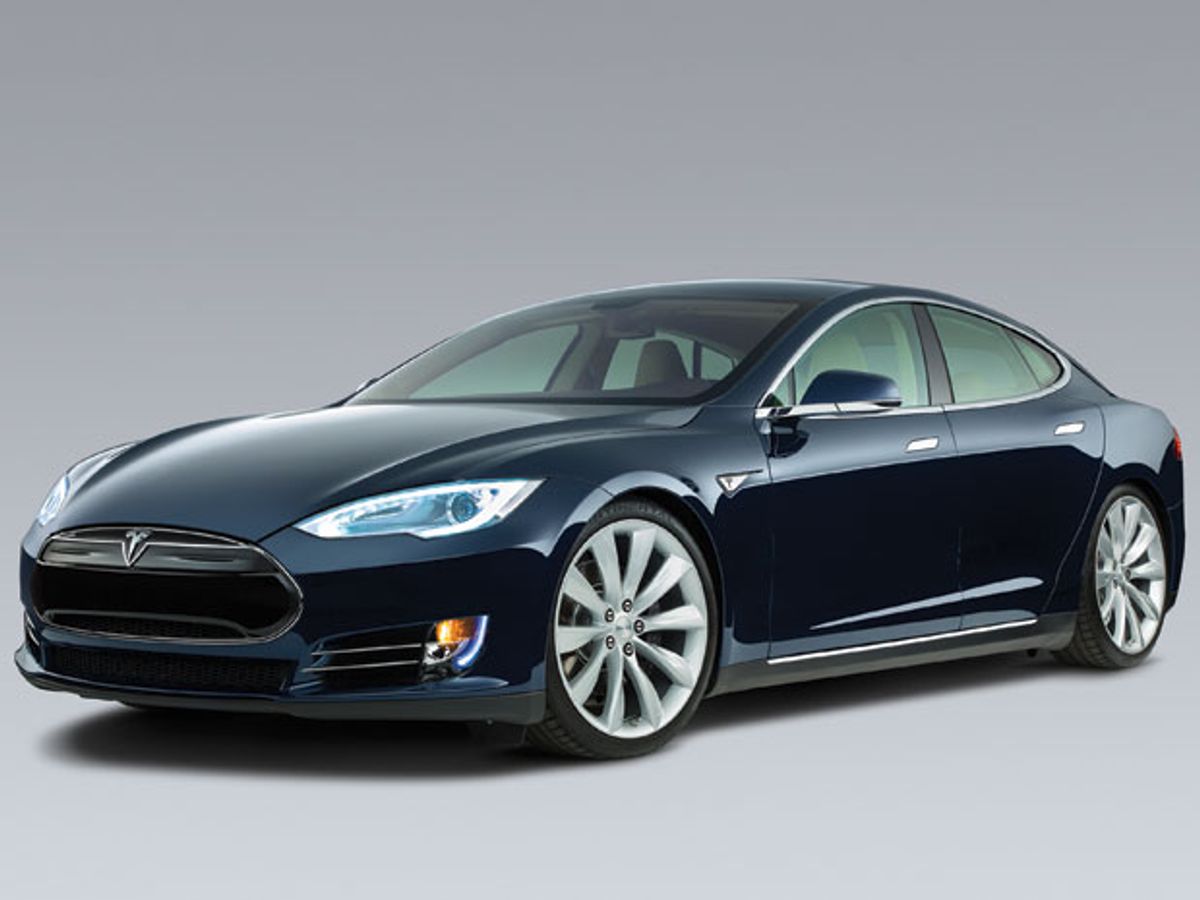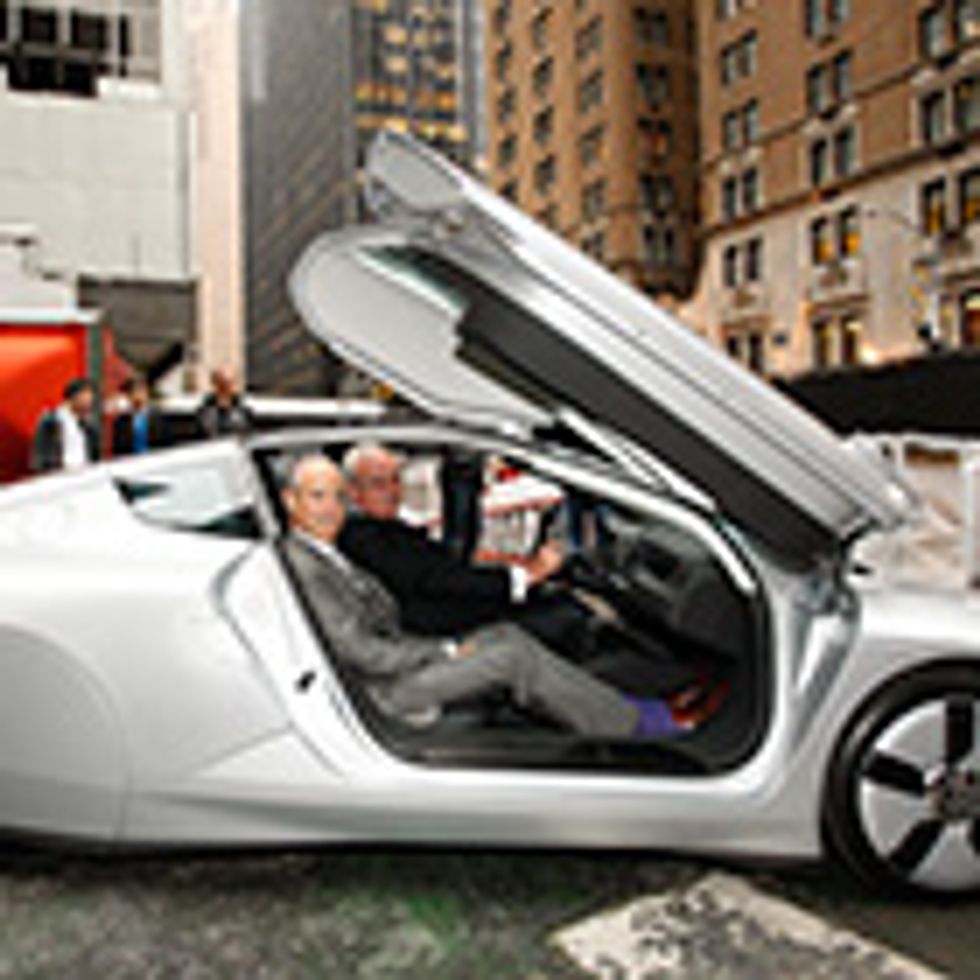Top Tech Cars 2013: Tesla Model S
The year’s most significant car just happens to be electric

Every electric vehicle comes freighted not only with batteries but with political baggage, too. Saviors to some, scapegoats to others, their honeymoon period is clearly over.
But in wintry Chicago, the Tesla Model S sedan managed over two fast-paced days to reaffirm the e-car’s potential—not as a political chip but as a means of transport. And judged on its lofty technical achievement alone, the Tesla is the year’s most significant automobile.
“We built a compelling car that just happens to be electric,” says Ted Merendino, product planner for the California-based Tesla Motors. “And we think the Model S is the first alternative fuel vehicle that’s done that.”
The Tesla isn’t the tiny, sluggish short-ranger that some people have come to expect EVs to be. With the largest of three available battery options, this swift, alluring sport sedan can cover an EPA-certified 265 miles (426 kilometers) on a charge, although Tesla claims 300 miles. In either case, it’s easily a new high for electric cars. It comes at a price: US $94 900 to start for the Model S Performance edition, rising to $101 600 for the version I tested. (From that, deduct $7500 in the form of a U.S. federal tax credit.)
On an opening drive, the Tesla’s enormous 85-kilowatt-hour battery indeed has me on pace for at least 426 km. The current flows from an under-floor sandwich of roughly 7000 Panasonic lithium-ion cells weighing some 590 kilograms (1300 pounds).
On a second-day run to Wisconsin, I nearly drain the battery after 320 km, but that includes two brutal, crawling hours in a Chicago traffic jam. That hard-charging day was also more about testing performance than range, including the Tesla’s stealthy, 4.4-second blasts from 0 to 97 km/h (0 to 60 mph) and a 210 km/h top speed.
Did I mention that the 310-kilowatt (416-horsepower) Tesla will beat the monstrous, gasoline-powered 413-kW (554-hp) BMW M5 from 0 to 100 mph? Credit here goes partly to the 600 newton meters (443 foot-pounds) of torque available instantly from the Tesla’s synchronous AC motor. Flick the Tesla’s throttle like a light switch and maximum torque is on tap from 0 to 5100 revolutions per minute. The rear-mounted, liquid-cooled motor can hum to 16 000 rpm, linked to rear wheels by a single-speed gearbox.
The Tesla hunts down internal-combustion prey with eerily silent remorselessness—so silent, it must be said, that the noises from the tires and from wind resistance become more obtrusive than in most other luxury cars. The low-mounted battery gives the Tesla a center of gravity on par with that of many supercars, a boon to stable handling. And the Model S feels impeccably planted through curves.
Yet although the Tesla doesn’t look heavy, it weighs in at 2108 kg, and the excess flab reveals itself as the speed and g forces climb. Push harder and the hefty back end bobs and weaves. When it comes to exhilarating handling, the Tesla is no BMW. It’s not even a Mazda.
The whiz-bang begins before you climb in, with retractable door handles that automatically emerge as you approach. It continues with the Tesla’s signature cabin feature, a 43-centimeter (17-inch) capacitive touch screen that looks like a pair of mating iPads.
Within its aluminum-intensive chassis and body, the Model S seats five. A cute-but-dubious option adds rear-facing child seats under the hatch for seven-passenger capability. Folding the second-row seats down expands rear cargo space to Home Depot proportions. And with no engine under the hood, there’s room for a useful front trunk, or as Tesla calls it, a “frunk,” as in a Porsche 911.
The EPA pegs the Tesla’s mileage at the equivalent of 2.6 liters per 100 kilometers (89 miles per gallon), calculating that a liter of gasoline is worth 8.9 kWh. That works out to an annual fuel cost of $700, based on 12 000 miles driven and home electricity priced at 12 cents per kWh. Compare that with a mere 224‑kW (300-hp) BMW 535i, whose 9.8 L/100 km (24 mpg) average will cost you $2250 a year in premium gasoline.
For home use, the Tesla’s 240-volt, 50-ampere Mobile Connector restores about 50 km of driving range per hour with its 10-kW onboard charger. Double up with the 20-kW Twin Charger unit, with home 240‑V, 80-A service, and you’ll add 100 km of range for each hour on the plug.
On my first night in Chicago, I pull into the Radisson Blu Aqua Hotel and plug into one of three 240-V ChargePoint stations in an underground lot. In 6 hours, the Tesla’s electric tank is replenished. The company has also begun installing proprietary 90‑kW DC Supercharger stations on both coasts that can add 240 km of driving range in 30 minutes. Those fill-ups will be free for the life of the car, the company pledges.
With prices high and sales slow, Tesla badly missed 2012 production targets, although it insists it remains on track to build 20 000 cars this year. Success may hinge on new versions, which trade power and range for a lower price. Available later this year, a $59 900 Model S combines a 40-kWh battery with 175 kW (235 hp), enough to travel 257 km and hit 97 km/h in a respectable 6.5 seconds.
Throw in the $7500 federal tax credit and that Model S will start at $52 400, roughly on par with a six-cylinder Audi A6, BMW 5-Series, or Mercedes E-Class—fine German cars, one and all. But none of them will turn heads or blow minds like the Tesla Model S. n
Price: US $101 600 (for the version tested), less $7500 U.S. tax credit Range: EPA-certified 265 miles (426 km) Power plant: Rear-mounted 310-kW (416-hp) motor



